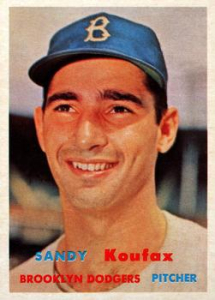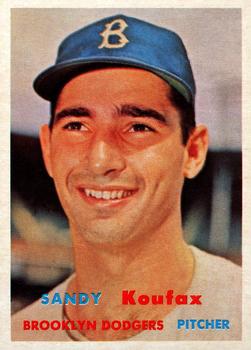August 1, 1957: Sandy Koufax mows down Cubs while Gil Hodges belts NL-record 13th grand slam
 Veteran New York sportswriters were impressed with 21-year-old Sandy Koufax’s overpowering four-hitter with 11 punchouts at Wrigley Field in the Brooklyn Dodgers’ one-sided win over the Chicago Cubs on August 1, 1957. “Sandy’s strikeout record against the Cubs is remarkable,” declared New York Times scribe Roscoe McGowen.1 Dick Young of the Daily News quipped, “Koufax, who fires a pretty good K-pitch against anyone, fattens up his whiff totals against Chicago.”2 While the Dodgers’ hard-throwing swingman racked up double-digit whiffs for the fourth consecutive time against the Cubs, teammate Gil Hodges blasted his National League record-setting 13th grand slam in an offensive explosion.
Veteran New York sportswriters were impressed with 21-year-old Sandy Koufax’s overpowering four-hitter with 11 punchouts at Wrigley Field in the Brooklyn Dodgers’ one-sided win over the Chicago Cubs on August 1, 1957. “Sandy’s strikeout record against the Cubs is remarkable,” declared New York Times scribe Roscoe McGowen.1 Dick Young of the Daily News quipped, “Koufax, who fires a pretty good K-pitch against anyone, fattens up his whiff totals against Chicago.”2 While the Dodgers’ hard-throwing swingman racked up double-digit whiffs for the fourth consecutive time against the Cubs, teammate Gil Hodges blasted his National League record-setting 13th grand slam in an offensive explosion.
Skipper Walter Alston’s two-time reigning NL pennant-winner Dodgers (57-42) were hitting on all cylinders. They had won 16 of 22 games since the All-Star break and trailed the Milwaukee Braves and St. Louis Cardinals by two games. “This a fascinating wing-ding race going on,” declared sportswriter Bill Lee, with the Cincinnati Reds and the surprising Philadelphia Phillies just four games off the lead.3
The Dodgers were also in a battle with Father Time and were no longer the offensive juggernaut they had been.4 Jackie Robinson had retired in the offseason, but the Dodgers still fielded the oldest set of position players in the league with Pee Wee Reese (38), Roy Campanella (35), Carl Furillo (35), Hodges (33), and Duke Snider (30) combining for more than seven decades of big-league experience and searching for one last hurrah for Brooklyn. The Dodgers’ departure from the borough they had called home since the club’s founding in 18835 was all but certain since the owners of all 16 big-league clubs had unanimously voted on May 28 to permit them (and the New York Giants) to relocate to California.6
Alston hoped to pad his team’s record in the final game of a whirlwind three-day, five-game series with the lowly Cubs as part of a 14-game road trip. Described as “terribly incompetent” and “pathetic” by Dick Young7 and a “depressing team to watch” in Newsday, rookie skipper Bob Scheffing’s Cubs were in last place with the worst record (33-65) in the big leagues and heading to their 11th straight losing season.8
Praised by Brooklyn sportswriter Stan Wyman as “One of the truly bright spots of the Dodger campaign this season,” Koufax was making his 24th career start.9 After logging just 100 1/3 innings in his first two seasons as a teenage bonus baby, Koufax showed signs of his immense promise in 1957, despite battling soreness in his left shoulder that sidelined him for three weeks in June.
And he especially feasted on the Cubs. His previous three starts against them included a complete-game four-hitter with 13 strikeouts at Wrigley Field on May 16, 12 more strikeouts in 7 2/3 innings in a win at Ebbets Field on June 4, and 11 in a seven-inning no-decision on July 19 at home. He entered this game with a 4-2 record with a 3.33 ERA and 83 strikeouts in 67 2/3 innings. His strikeout ratio of 11.04 per nine innings was the highest in the majors.
Wrigley Field welcomed 8,075 fans to the friendly confines on the north side of Chicago on a warm and humid Wednesday afternoon with temperatures in the mid-80s for the 1:20 P.M. start time.10 Though the results of the preceding two twin bills might have been expected,11 with the Dodgers winning three of the four games to improve their season record to 14-3 against the Cubs, they were all closely-contested, low-scoring affairs. Each was decided by one run with just 16 total runs scored.
In this game, however, the Dodgers came out swinging so ferociously that “any detailed account of the scoring,” wrote Roscoe McGowen, “would be unnecessary and perhaps inadequate. It is doubtful that the … customers could follow it.”12 The Dodgers punished four pitchers, collecting what proved to be a season-high 18 hits (including 17 singles) for 12 runs (their second highest total of the season), took two walks, and benefited from two hit by pitches, one wild pitch, and six errors while coming to the plate a staggering 51 times.
Brooklyn took the lead in the first on Hodges’s one-out sacrifice fly to drive in leadoff hitter Jim Gilliam, who reached on second baseman Jerry Kindall’s error and moved to third on Snider’s single.
Cubs starting pitcher Tom Poholsky, who entered the game with a 1-6 season record and a 31-51 record in parts of six seasons, escaped a jam in the second after he plunked Charlie Neal and Campanella singled to start the frame, but was not around by the end of the next inning. Singles by Snider, Sandy Amoros, and Randy Jackson resulted in the Dodgers’ second run.
After a wild pitch, Neal was plunked again. Perhaps sensing that the game would soon be out of hand, Alston replaced shortstop Neal, who had been suffering from a boil on his right knee, with Reese.13 Campanella’s single drove in two to make it 4-0 and send Poholsky to the showers in what proved to be the last game he ever started in the majors.
Koufax – who had pitched two innings of relief and yielded just one hit, a home run to Bob Speake, in the second game of the doubleheader two days earlier – looked shaky early in this contest. In the first inning Speake and Lee Walls singled with one out but were left stranded.
Koufax began the fourth by walking Walls, and Walt Moryn followed with a single. Ernie Banks drove both home on a long home run to deep left field to pull the Cubs to within one run, 4-3. Banks’ 23rd round-tripper of the season provided only “fleeting illusion of a contest,” jibed Young.14 Koufax regained his composure, worked around a two-out walk, and emphatically ended the inning by recording his seventh strikeout of the game.
Moments after Banks’ blast, the Dodgers blew the game open. Reese led off with a walk. Pitcher Bob Anderson fielded Koufax’s one-out bunt and threw to second, pegging a sliding Reese on the back of the neck. Don Zimmer replaced Reese, becoming the Dodgers’ third shortstop of the game.
Gilliam’s RBI single and Furillo’s single forced a pitching change with the left-hand-hitting Snider coming up and the bases juiced. Journeyman southpaw Dick Littlefield, with his eighth team in eight big-league seasons, retired Snider on a popup to first.
The second half of the Dodgers’ lefty-righty slugging duo, Gil Hodges, stepped to the plate. While Duke had the Hollywood good looks, Hodges “has the kind of muscles that make people glad he’s an easy-going guy,” wrote Newsday.15 Hodges planted Littlefield’s 1-and-1 pitch deep into the left-field bleachers to propel the Dodgers to a 9-3 lead.
It was his NL-record-setting 13th career grand slam, breaking the mark he had shared with Rogers Hornsby and Ralph Kiner.16 “I know that it was a fastball that zipped down the middle,” said Hodges about his 15th home run of the season. “I caught it well. But I didn’t think it would carry into the bleacher.”17 A Chicagoan caught the historic ball and returned it to Hodges after the game.18
The Dodgers tormented Littlefield again in the next innings. After Jackson’s and Zimmer’s inning-opening singles in the sixth, Campanella’s sacrifice fly made it 10-3. Zimmer moved up on Koufax’s bunt and scored the Dodgers’ 11th run on Gilliam’s single. Gino Cimoli, pinch-hitting for Snider, led off the seventh with a single and then raced home on Littlefield’s errant throw and three-base error on Hodges’ tapper to the mound to make it 12-3.19
Koufax cruised after his fourth-inning hiccup, holding the Cubs hitless in the final five innings of the game. The Cubs’ only baserunners were walks to Moryn in the sixth and Jim Bolger in the ninth. In completing his second game of the season, Koufax made 146 pitches (88 strikes) and issued four walks in a commanding four-hitter.20 His 11 strikeouts marked the fourth (and final) time of the season he reached double digits in punchouts – all against the Cubs – and the fifth time in his career.
Additional context sheds light on Koufax’s accomplishments in an era when strikeouts were much less common than in the twenty-first century. In 1957, major-league pitchers struck out 10 or more batters in a game 44 times, and 11 or more just 24 times, of which Koufax had four. Only two other pitchers, the Cubs’ Dick Drott and the Phillies’ Jack Sanford, fanned at least 11 twice.
As it turned out, the Dodgers went into a tailspin after what proved to be Koufax’s final victory of 1957. In their last season in Brooklyn, they lost 28 of their final 54 games to finish in third place, 11 games behind the Braves. Koufax struggled, too, posting a 5.53 ERA in 27 2/3 innings to conclude his third campaign with a 5-4 record (3.88 ERA) and 122 strikeouts in 104 1/3 innings.
Acknowledgments
This article was fact-checked by Jim Sweetman and copy-edited by Len Levin.
Sources
In addition to the sources cited in the Notes, the author accessed Retrosheet.org, Baseball-Reference.com, SABR.org, and the following:
https://www.baseball-reference.com/boxes/CHN/CHN195708010.shtml
https://www.retrosheet.org/boxesetc/1957/B08010CHN1957.htm
Vaughan, Irving. “Hodges Gets 13th Four Run Hit; N.L. Mark,” Chicago Tribune, August 2, 1957: F2.
Notes
1 Roscoe McGowen, “Dodgers Crush Cubs as Hodges’ 13th Slam Sets Record,” New York Times, August 2, 1957: 27.
2 Dick Young, “Brooks Clobber Cubs, 12-3; Gil’s 13th Slam Sets Mark,” New York Daily News, August 2, 1957: 46.
3 Bill Lee, “With Malice Toward None,” Hartford (Connecticut) Courant, August 2, 1957: 19.
4 Some context: From 1948 to 1956, the Dodgers led the NL in scoring five times and finished second three times. They paced in NL in home runs every season from 1949 through 1955 and finished second in 1956. In 1957 the older Dodgers finished in fourth place in both categories.
5 The Dodgers trace their history back to 1883 as part of the Interstate Association, the Players Association (1884-1889), and beginning in 1890 in the National League. See Lloyd Johnson and Miles Wolff, The Encyclopedia of Minor League Baseball, 2nd edition (Durham, North Carolina: Baseball America, 1997), 45.
6 Chris Landers, “Just Why Did the Dodgers and Giants Move from New York to California,” MLB.com, January 25, 2019, https://www.mlb.com/cut4/why-did-the-dodgers-and-giants-move-to-california-c303090362.
7 Young, “Brooks Clobber Cubs, 12-3; Gil’s 13th Slam Sets Mark.”
8 “Hodges’ 13th Slam Breaks NL Record,” Newsday (Long Island, New York), August 2, 1957: 66.
9 Stan Wyman, “Dodgers Tangle with Braves,” Brooklyn Daily, June 13, 1957: 24.
10 “The Weather,’ Chicago Tribune, August 1, 1957: 1.
11 Both doubleheaders resulted from makeup games of rainouts earlier in the season.
12 McGowen, “Dodgers Crush Cubs as Hodges’ 13th Slam Sets Record.”
13 “Hodges’ 13th Slam Breaks NL Record.”
14 Young, “Brooks Clobber Cubs, 12-3; Gil’s 13th Slam Sets Mark.”
15 “Hodges’ 13th Slam Breaks NL Record.”
16 Hodges hit one more grand slam, in August 1958 against Bob Trowbridge of the Milwaukee Braves, and retired with 14. Through the 2024 season, Willie McCovey held the NL record of 18 grand slams.
17 George Lazarus (Associated Press), “Record Grand Slam ‘Sort of a Thrill,’” Buffalo Evening News, August 2, 1957: 25.
18 Jerry Holtzman, “Bums Rout Cubs 12-3 on 18 Hits,” Chicago Sun-Times, August 2, 1957: 53. Local North Sider Chilla caught he ball; in exchange for the ball, he received a ball autographed by the entire Dodger squad.
19 It is not clear if Littlefield threw to second (which would be expected) or to first. Baseball-Reference and Retrosheet record only that Littlefield committed an error. No mention of this error could be found in any newspaper story about the game.
20 Pitch count from game account on Baseball-Reference.com.
Additional Stats
Brooklyn Dodgers 12
Chicago Cubs 3
Wrigley Field
Chicago, IL
Box Score + PBP:
Corrections? Additions?
If you can help us improve this game story, contact us.


